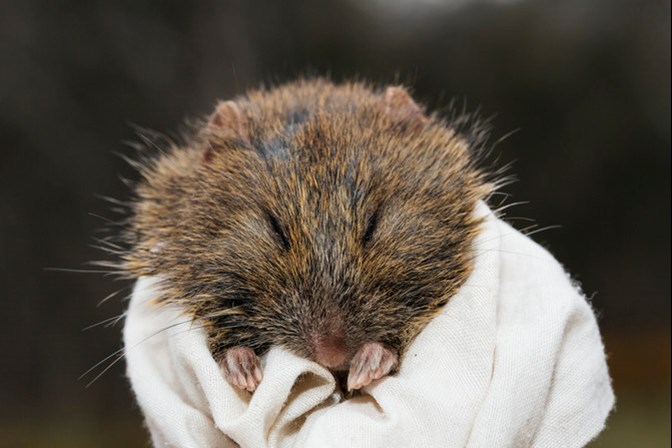Bushfires and climate change threaten the future of native Australian rodent, the Broad-toothed rat.
The chubby-cheeked Broad-toothed Rat has disappeared from 53% of sites where they have previously been found in a decline linked to climate change – and now the devastating 2019-2020 bushfires have raised fresh concerns for their long-term survival in Victoria.
September 7 marks National Threatened Species Day, and this year Museums Victoria is highlighting an adorable native rodent, the Tooarrana, or Broad-toothed Rat, endangered in Victoria and fighting against threats from climate change and bushfires.
Research from Museums Victoria published in CSIRO Publishing’s Wildlife Research journal earlier this year highlights an alarming decline in the distribution of the Broad-toothed Rat, linked to the effects of climate change restricting their habitat over the last several decades. When the catastrophic bushfires of 2019-2020 swept through the Victorian High Country, many of the few remaining strongholds for this species were burnt.
As part of Victoria’s Bushfire Biodiversity Response and Early Recovery program, Museums Victoria and partners will return to fire-ravished sites to search for answers into how populations of the Broad-toothed Rat are faring in the wake of the fires and what the future may hold for this species.
Known by Australia’s First Peoples as Tooarrana, the Broad-toothed Rat (Mastacomys fuscus) is a native species of rodent found only in south-Eastern Australia. They are described as shy and gentle, with a cute chubby-cheeked complexion and sweet-natured personalities.
‘Broad-toothed Rats are unique among Australian rodents in that they feed almost exclusively on sedges and grasses, and live only in cool and wet environments’, explains Museums Victoria’s senior curator of mammals and lead researcher, Dr Kevin Rowe. While the species itself is listed as threatened, the Victorian populations are listed as endangered.
In the long-term study published in April, Kevin and his team used scat surveys and historical records to show that the Broad-toothed Rat has disappeared from 53% of sites where they were found in Victoria before 1990. Historical climate data shows that the mean annual temperature at each site had on average increased by 0.7°C since the species was last seen there.
Sites where the species persisted were significantly more likely to be at higher elevations, have a higher precipitation and lower temperatures. Increasing temperatures and decreased annual rainfall are expected to continue to push the species to higher elevations and cooler, wetter areas.
'If the current climate trend continues, we could see this species pushed further and further upwards, eventually disappearing from warmer, low-elevation areas. Climate change poses a significant threat to the persistence of Broad-toothed Rats, and to many other Australian animals.’
From his recent fieldwork in the freezing conditions of the Victorian Eastern Alps, Dr Rowe describes sobering sights of the charred runways the rats use to move through the thick undergrowth- where previously it was hard to see rat activities through the dense bush, their runways are now clearly visible against the blackened earth.
‘Getting on the ground to understand the intensity and severity of the fires is essential to know how populations within the burn are faring. Impacts like feral horses and predators can worsen after a fire and we need to know about how these impacts have changed’, he adds, noting on his recent trip ‘horses, deer and rabbits were everywhere’.
Dr Rowe points to the importance of museum collections and records for tackling the response to major ecological events and impacts like climate change and bushfires.
‘Museums house the records of our changing wildlife that give us the power to understand how species will respond to future threats. In order to act on threats like bushfires and climate change, we need information about where the species was before these events happen.’
With study sites starting to open up after the winter snow season, Dr Rowe and his team maintain hope of finding the Broad-toothed Rats when they resume fieldwork later this year. Until then, he stresses the importance of promoting awareness and love for this lesser-known species.
‘There is no greater threat to rodents and small mammals in Australia than lack of knowledge and we can take action on that’.
Meet the Broad-toothed Rat with Dr Kevin Rowe in our video below:
Links
Follow Dr Kevin Rowe on Twitter @MVMammals
For interviews with Dr Kevin Rowe and media enquiries please contact:









